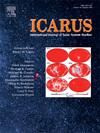Exploring water-ice deposits in lunar polar craters with Chandrayaan-2 DFSAR data
IF 2.5
2区 物理与天体物理
Q2 ASTRONOMY & ASTROPHYSICS
引用次数: 0
Abstract
Detection of water-ice deposits using synthetic aperture radar (SAR) is a cost-effective, and efficient approach to understand lunar water resources. As water is crucial to supporting human-based space exploration, current and near upcoming lunar missions are primary concentrated on mapping and quantification of water ice exposures on surface and subsurface levels. The circular polarization ratio greater than one (CPR >1) derived using the orbital radar observations is considered as an important SAR derived parameter for water-ice detection. This study aims to investigate 14 craters near the lunar poles with high CPR (CPR >1), as identified in previous studies, using the L-band (24 cm) dual frequency synthetic aperture radar (DFSAR) onboard Chandrayaan-2. In addition to CPR, we computed the degree of polarization (DOP) after applying parallax error correction that helps in reducing misinterpretation. Our findings are based on orthorectified DFSAR calibrated data analysis. We found that the CPR of crater interiors is not significantly different from that of their surroundings, and this pattern is consistent throughout all the 14 craters selected. Further, we also found a linear inverse relationship between CPR and DOP for the interior and exteriors of the craters, with R2 ∼ 0.99, indicating a strong correlation between these two parameters. We found only ∼2 % of total pixels are above CPR > 1, which indicates that there is less possibility of homogeneous water-ice but the possibility of water-ice mixed with the subsurface regolith cannot be ruled out.
利用 Chandrayaan-2 DFSAR 数据探索月球极地陨石坑中的水冰沉积物
本文章由计算机程序翻译,如有差异,请以英文原文为准。
求助全文
约1分钟内获得全文
求助全文
来源期刊

Icarus
地学天文-天文与天体物理
CiteScore
6.30
自引率
18.80%
发文量
356
审稿时长
2-4 weeks
期刊介绍:
Icarus is devoted to the publication of original contributions in the field of Solar System studies. Manuscripts reporting the results of new research - observational, experimental, or theoretical - concerning the astronomy, geology, meteorology, physics, chemistry, biology, and other scientific aspects of our Solar System or extrasolar systems are welcome. The journal generally does not publish papers devoted exclusively to the Sun, the Earth, celestial mechanics, meteoritics, or astrophysics. Icarus does not publish papers that provide "improved" versions of Bode''s law, or other numerical relations, without a sound physical basis. Icarus does not publish meeting announcements or general notices. Reviews, historical papers, and manuscripts describing spacecraft instrumentation may be considered, but only with prior approval of the editor. An entire issue of the journal is occasionally devoted to a single subject, usually arising from a conference on the same topic. The language of publication is English. American or British usage is accepted, but not a mixture of these.
 求助内容:
求助内容: 应助结果提醒方式:
应助结果提醒方式:


